brake KIA Optima 2013 3.G Owner's Manual
[x] Cancel search | Manufacturer: KIA, Model Year: 2013, Model line: Optima, Model: KIA Optima 2013 3.GPages: 382, PDF Size: 8.75 MB
Page 5 of 382
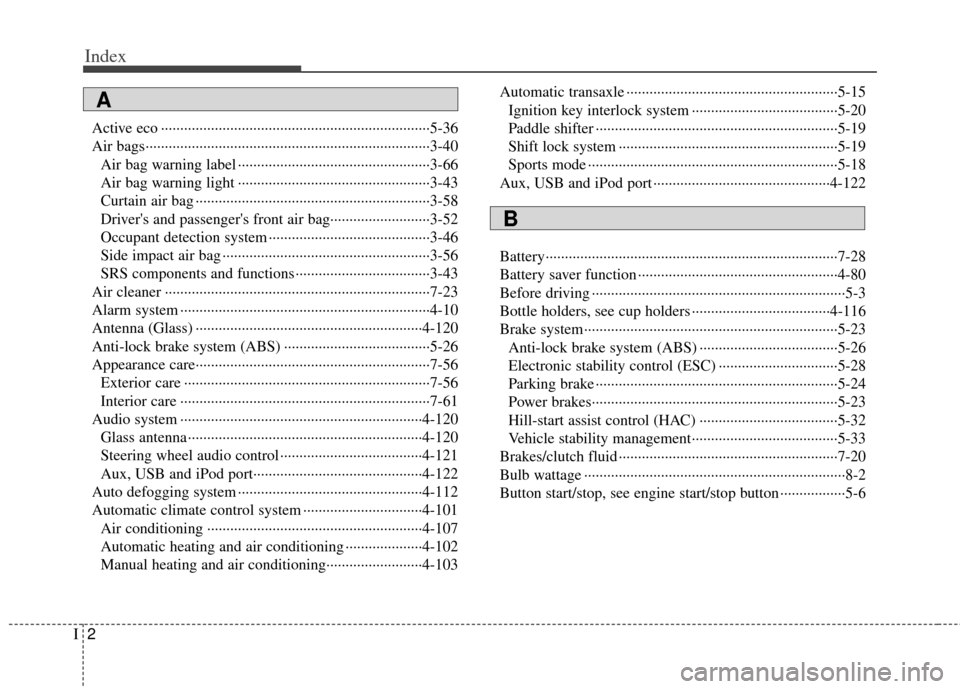
Index
2I
Active eco ··················\
··················\
··················\
················5-36
Air bags··················\
··················\
··················\
··················\
··3-40Air bag warning label ··················\
··················\
··············3-66
Air bag warning light ··················\
··················\
··············3-43
Curtain air bag ··················\
··················\
··················\
·······3-58
Driver's and passenger's front air bag··········\
················3-52
Occupant detection system ··················\
··················\
······3-46
Side impact air bag ··················\
··················\
··················\
3-56
SRS components and functions ··················\
·················3-43\
Air cleaner ··················\
··················\
··················\
···············7-23
Alarm system ··················\
··················\
··················\
···········4-10
Antenna (Glass) ··················\
··················\
··················\
·····4-120
Anti-lock brake system (ABS) ··················\
··················\
··5-26
Appearance care··················\
··················\
··················\
·······7-56 Exterior care ··················\
··················\
··················\
··········7-56
Interior care ··················\
··················\
··················\
···········7-61
Audio system ··················\
··················\
··················\
·········4-120 Glass antenna ··················\
··················\
··················\
·······4-120
Steering wheel audio control ··················\
··················\
·4-121
Aux, USB and iPod port··················\
··················\
········4-122
Auto defogging system ··················\
··················\
············4-112
Automatic climate control system ··················\
·············4-101 Air conditioning ··················\
··················\
··················\
··4-107
Automatic heating and air conditioning ··················\
··4-102
Manual heating and air conditioning··················\
·······4-103 Automatic transaxle ··················\
··················\
··················\
·5-15
Ignition key interlock system ··················\
··················\
··5-20
Paddle shifter ··················\
··················\
··················\
·········5-19
Shift lock system ··················\
··················\
··················\
···5-19
Sports mode ··················\
··················\
··················\
···········5-18
Aux, USB and iPod port ··················\
··················\
··········4-122
Battery··················\
··················\
··················\
··················\
····7-28
Battery saver function ··················\
··················\
················4-80
Before driving ··················\
··················\
··················\
············5-3
Bottle holders, see cup holders ··················\
··················\
4-116
Brake system··················\
··················\
··················\
············5-23 Anti-lock brake system (ABS) ··················\
··················\
5-26
Electronic stability control (ESC) ··················\
·············5-28
Parking brake ··················\
··················\
··················\
·········5-24
Power brakes··················\
··················\
··················\
··········5-23
Hill-start assist control (HAC) ··················\
··················\
5-32
Vehicle stability management··················\
··················\
··5-33
Brakes/clutch fluid ··················\
··················\
··················\
···7-20
Bulb wattage ··················\
··················\
··················\
··············8-2
Button start/stop, see engine start/stop button ·················5-6
A
B
Page 7 of 382
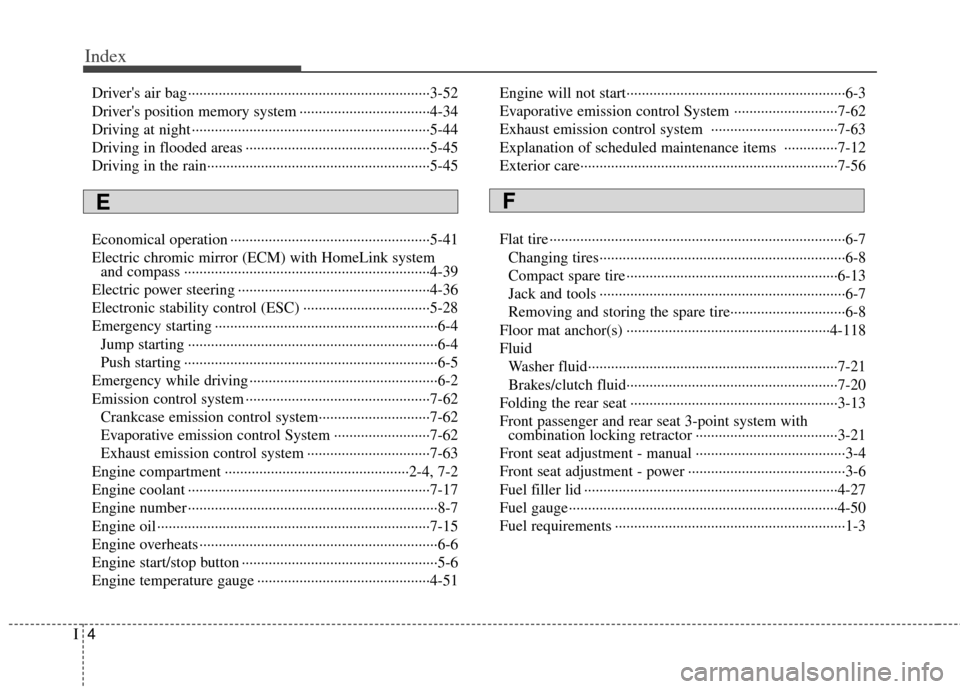
Index
4I
Driver's air bag··················\
··················\
··················\
·········3-52
Driver's position memory system ··················\
················4-34
Driving at night ··················\
··················\
··················\
········5-44
Driving in flooded areas ··················\
··················\
············5-45
Driving in the rain··················\
··················\
··················\
····5-45
Economical operation ··················\
··················\
················5-41
Electric chromic mirror (ECM) with HomeLink system and compass ··················\
··················\
··················\
··········4-39
Electric power steering ··················\
··················\
··············4-36
Electronic stability control (ESC) ··················\
···············5-28
Emergency starting ··················\
··················\
··················\
····6-4 Jump starting ··················\
··················\
··················\
···········6-4
Push starting ··················\
··················\
··················\
············6-5
Emergency while driving ··················\
··················\
·············6-2
Emission control system ··················\
··················\
············7-62 Crankcase emission control system··················\
···········7-62
Evaporative emission control System ··················\
·······7-62
Exhaust emission control system ··················\
··············7-63
Engine compartment ··················\
··················\
············2-4, 7-2
Engine coolant ··················\
··················\
··················\
·········7-17
Engine number ··················\
··················\
··················\
···········8-7
Engine oil ··················\
··················\
··················\
·················7-15\
Engine overheats ··················\
··················\
··················\
········6-6
Engine start/stop button ··················\
··················\
···············5-6
Engine temperature gauge ··················\
··················\
·········4-51 Engine will not start··················\
··················\
··················\
···6-3
Evaporative emission control System ··················\
·········7-62
Exhaust emission control system ··················\
···············7-63
Explanation of scheduled maintenance items ··············7-12
Exterior care··················\
··················\
··················\
·············7-56
Flat tire ··················\
··················\
··················\
··················\
·····6-7
Changing tires··················\
··················\
··················\
··········6-8
Compact spare tire ··················\
··················\
··················\
·6-13
Jack and tools ··················\
··················\
··················\
··········6-7
Removing and storing the spare tire···········\
··················\
·6-8
Floor mat anchor(s) ··················\
··················\
·················4-11\
8
Fluid Washer fluid··················\
··················\
··················\
···········7-21
Brakes/clutch fluid··················\
··················\
··················\
·7-20
Folding the rear seat ··················\
··················\
··················\
3-13
Front passenger and rear seat 3-point system with combination locking retractor ··················\
··················\
·3-21
Front seat adjustment - manual ··················\
··················\
···3-4
Front seat adjustment - power ··················\
··················\
·····3-6
Fuel filler lid ··················\
··················\
··················\
············4-27
Fuel gauge··················\
··················\
··················\
················4-50
Fuel requirements ··················\
··················\
··················\
······1-3
EF
Page 10 of 382
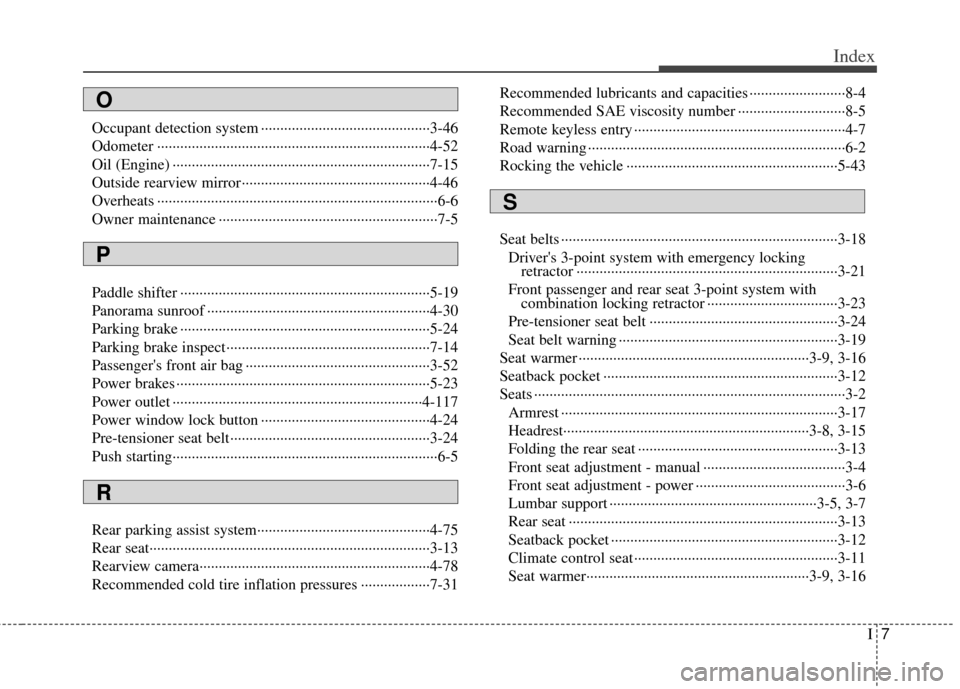
I7
Index
Occupant detection system ··················\
··················\
········3-46
Odometer ··················\
··················\
··················\
·················4-52\
Oil (Engine) ··················\
··················\
··················\
·············7-15
Outside rearview mirror··················\
··················\
·············4-46
Overheats ··················\
··················\
··················\
··················\
·6-6
Owner maintenance ··················\
··················\
··················\
···7-5
Paddle shifter ··················\
··················\
··················\
···········5-19
Panorama sunroof ··················\
··················\
··················\
····4-30
Parking brake ··················\
··················\
··················\
···········5-24
Parking brake inspect··················\
··················\
·················7-14\
Passenger's front air bag ··················\
··················\
············3-52
Power brakes ··················\
··················\
··················\
············5-23
Power outlet ··················\
··················\
··················\
···········4-117
Power window lock button ··················\
··················\
········4-24
Pre-tensioner seat belt··················\
··················\
················3-24
Push starting··················\
··················\
··················\
···············6-5
Rear parking assist system··················\
··················\
·········4-75
Rear seat··················\
··················\
··················\
··················\
·3-13
Rearview camera··················\
··················\
··················\
······4-78
Recommended cold tire inflation pressures ··················\
7-31Recommended lubricants and capacities ··················\
·······8-4
Recommended SAE viscosity number ··················\
··········8-5
Remote keyless entry ··················\
··················\
··················\
·4-7
Road warning ··················\
··················\
··················\
·············6-2
Rocking the vehicle ··················\
··················\
··················\
·5-43
Seat belts ··················\
··················\
··················\
··················\
3-18
Driver's 3-point system with emergency locking retractor ··················\
··················\
··················\
··············3-21
Front passenger and rear seat 3-point system with combination locking retractor ··················\
················3-23
Pre-tensioner seat belt ··················\
··················\
·············3-24
Seat belt warning ··················\
··················\
··················\
···3-19
Seat warmer ··················\
··················\
··················\
······3-9, 3-16
Seatback pocket ··················\
··················\
··················\
·······3-12
Seats ··················\
··················\
··················\
··················\
·········3-2 Armrest ··················\
··················\
··················\
··················\
3-17
Headrest················\
··················\
··················\
············3-8, 3-15
Folding the rear seat ··················\
··················\
················3-13
Front seat adjustment - manual ··················\
··················\
·3-4
Front seat adjustment - power ··················\
··················\
···3-6
Lumbar support ··················\
··················\
··················\
3-5, 3-7
Rear seat ··················\
··················\
··················\
················3-13
Seatback pocket ··················\
··················\
··················\
·····3-12
Climate control seat ··················\
··················\
·················3-11\
Seat warmer··················\
··················\
··················\
····3-9, 3-16
O
P
R
S
Page 16 of 382

Introduction
41
Use of MTBE
Kia recommends avoiding fuels contain-
ing MTBE (Methyl Tertiary Butyl Ether)
over 15.0% vol. (Oxygen Content 2.7%
weight) in your vehicle.
Fuel containing MTBE over 15.0% vol.
(Oxygen Content 2.7% weight) may
reduce vehicle performance and produce
vapor lock or hard starting.
Do not use methanol
Fuels containing methanol (wood alco-
hol) should not be used in your vehicle.
This type of fuel can reduce vehicle per-
formance and damage components of
the fuel system.
Fuel Additives
Kia recommends that you use good qual-
ity gasolines treated with detergent addi-
tives such as TOP TIER Detergent
Gasoline, which help prevent deposit for-
mation in the engine. These gasolines
will help the engine run cleaner and
enhance performance of the Emission
Control System. For more information on
TOP TIER Detergent Gasoline, please
go to the website (www
.toptiergas.com).
For customers who do not use TOP Tier
Detergent Gasoline regularly, and have
problems starting or the engine does not
run smoothly, additives that you can buy
separately may be added to the gasoline.
If TOP TIER Detergent Gasoline is not
available, one bottle of additive added to
the fuel tank at every 12,000 km or every
engine oil change is recommended.
Additives are available from your author-
ized Kia dealer along with information on
how to use them. Do not mix other addi-
tives.
Operation in foreign countries
If you are going to drive your vehicle in
another country, be sure to:
Observe all regulations regarding reg- istration and insurance.
Determine that acceptable fuel is avail- able. No special break-in period is needed. By
following a few simple precautions for the
first 1,000 km (600 miles) you may add to
the performance, economy and life of
your vehicle.
Do not race the engine.
While driving, keep your engine speed
(rpm, or revolutions per minute)
between 2,000 rpm and 4,000 rpm.
Do not maintain a single speed for long periods of time, either fast or slow.
Varying engine speed is needed to
properly break-in the engine.
Avoid hard stops, except in emergen- cies, to allow the brakes to seat prop-
erly.
Don't let the engine idle longer than 3 minutes at one time.
Don't tow a trailer during the first 2,000 km (1,200 miles) of operation.
CAUTION
Your New Vehicle Limited Warrantymay not cover damage to the fuelsystem and any performance prob- lems that are caused by the use offuels containing methanol or fuelscontaining MTBE (Methyl TertiaryButyl Ether) over 15.0% vol.(Oxygen Content 2.7% weight.)
VEHICLE BREAK-IN PROCESS
Page 17 of 382

15
Introduction
INDICATOR SYMBOLS ON THE INSTRUMENT CLUSTER
Seat belt warning light
High beam indicator
Turn signal indicator
ABS warning light*
Parking brake & Brake fluid
warning light
Engine oil pressure warning light
Charging system warning light
ESC indicator
ESC OFF indicator
Malfunction indicator
Air bag warning light
Cruise indicator*
Cruise SET indicator*
Low fuel level warning light
❈ For more detailed explanations, refer to “Instrument cluster” in section 4.
Door ajar warning light
Trunk lid open warning light
Front fog light indicator*
Engine coolant temperature
warning light
Electric power steering (EPS)
system warning light*
Shift pattern indicator
* : if equipped ECOMINDER
®indicator*ECO
Immobilizer indicator*
Page 19 of 382
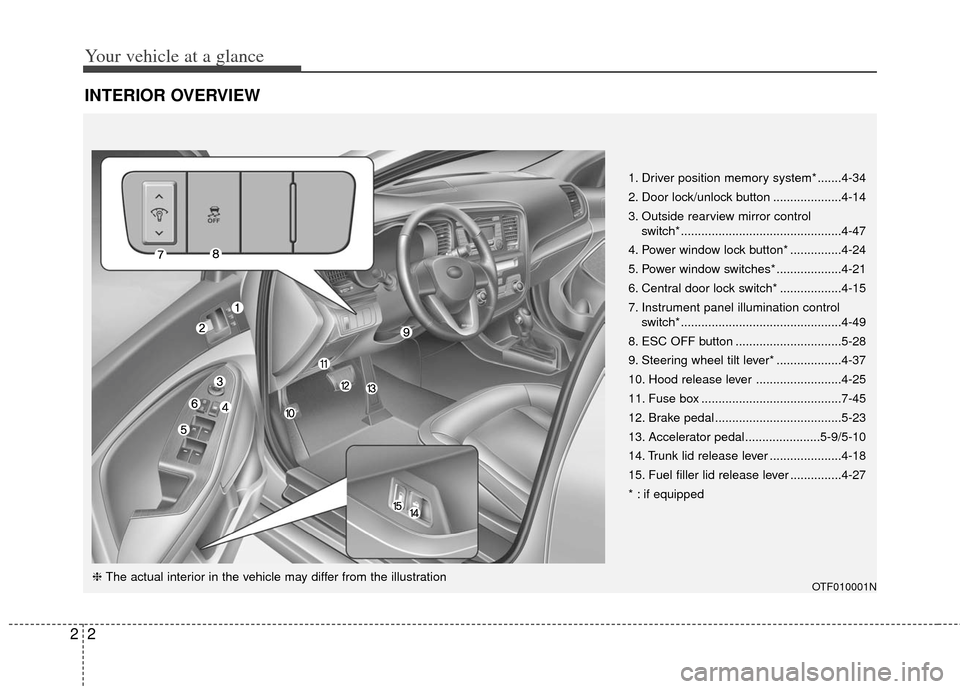
Your vehicle at a glance
22
INTERIOR OVERVIEW
1. Driver position memory system* .......4-34
2. Door lock/unlock button ....................4-14
3. Outside rearview mirror control switch* ...............................................4-47
4. Power window lock button* ...............4-24
5. Power window switches* ...................4-21
6. Central door lock switch* ..................4-15
7. Instrument panel illumination control switch* ...............................................4-49
8. ESC OFF button ...............................5-28
9. Steering wheel tilt lever* ...................4-37
10. Hood release lever .........................4-25
11. Fuse box .........................................7-45
12. Brake pedal .....................................5-23
13. Accelerator pedal......................5-9/5-10
14. Trunk lid release lever .....................4-18
15. Fuel filler lid release lever ...............4-27
* : if equipped
OTF010001N❈ The actual interior in the vehicle may differ from the illustration
Page 21 of 382
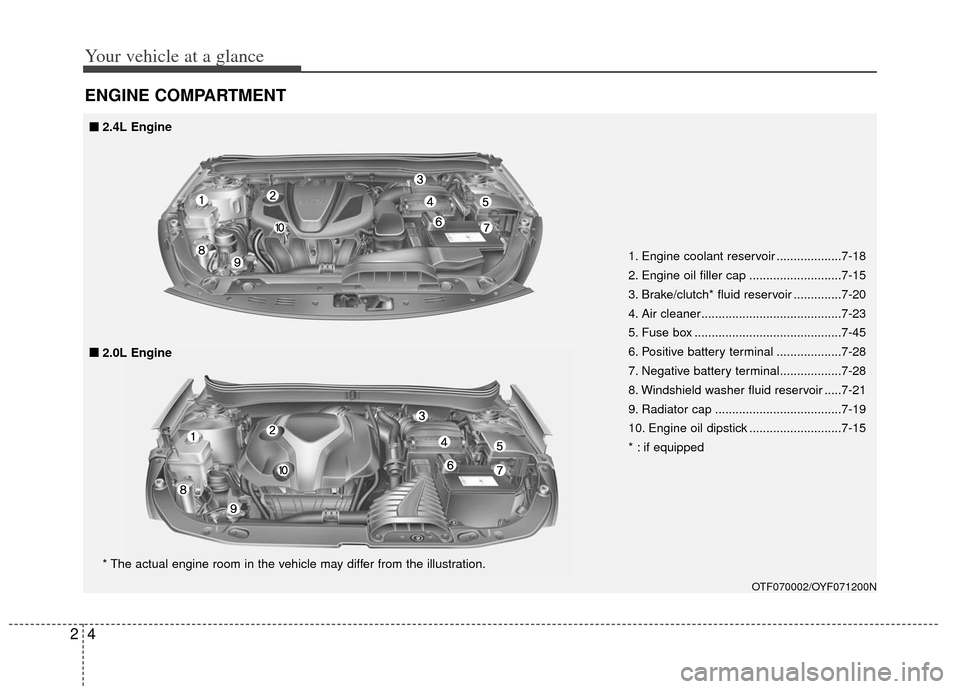
Your vehicle at a glance
42
ENGINE COMPARTMENT
1. Engine coolant reservoir ...................7-18
2. Engine oil filler cap ...........................7-15
3. Brake/clutch* fluid reservoir ..............7-20
4. Air cleaner.........................................7-23
5. Fuse box ...........................................7-45
6. Positive battery terminal ...................7-28
7. Negative battery terminal..................7-28
8. Windshield washer fluid reservoir .....7-21
9. Radiator cap .....................................7-19
10. Engine oil dipstick ...........................7-15
* : if equipped
OTF070002/OYF071200N
* The actual engine room in the vehicle may differ from the illustration.
■
■
2.4L Engine
■
■ 2.0L Engine
Page 36 of 382

315
Safety features of your vehicle
Headrest
The rear seat(s) is equipped with head-
rests in the outboard seating positions for
the occupant's safety and comfort.
The headrest not only provides comfort
for passengers, but also helps protect the
head and neck in the event of a collision.
WARNING
For maximum effectiveness incase of an accident, the headrest
should be adjusted so the middle
of the headrest is at the same
height of the center of gravity of
an occupant's head. Generally,
the center of gravity of most peo-
ple's head is similar with the
height of the top of their eyes.
Also adjust the headrest as close
to your head as possible. For this
reason, the use of a cushion that
holds the body away from the
seatback is not recommended.
Do not operate the vehicle with the headrests removed as severe
injury to an occupant may occur
in the event of an accident.
Headrests may provide protec-
tion against severe neck injuries
when properly adjusted.
OMG038401
WARNING- Cargo
Cargo should always be secured to
prevent it from being thrown about
the vehicle in a collision and caus-
ing injury to the vehicle occupants.
Do not place objects in the rear
seats, since they cannot be proper-
ly secured and may hit the front
seat occupants in a frontal colli-
sion.
WARNING - Cargo loading
Make sure the engine is off, the
automatic transaxle is in P (Park)
or the manual transaxle is in
Reverse or 1st, and the parking
brake is securely applied whenever
loading or unloading cargo. Failure
to take these steps may allow the
vehicle to move if the shift lever is
inadvertently moved to another
position.
Page 84 of 382
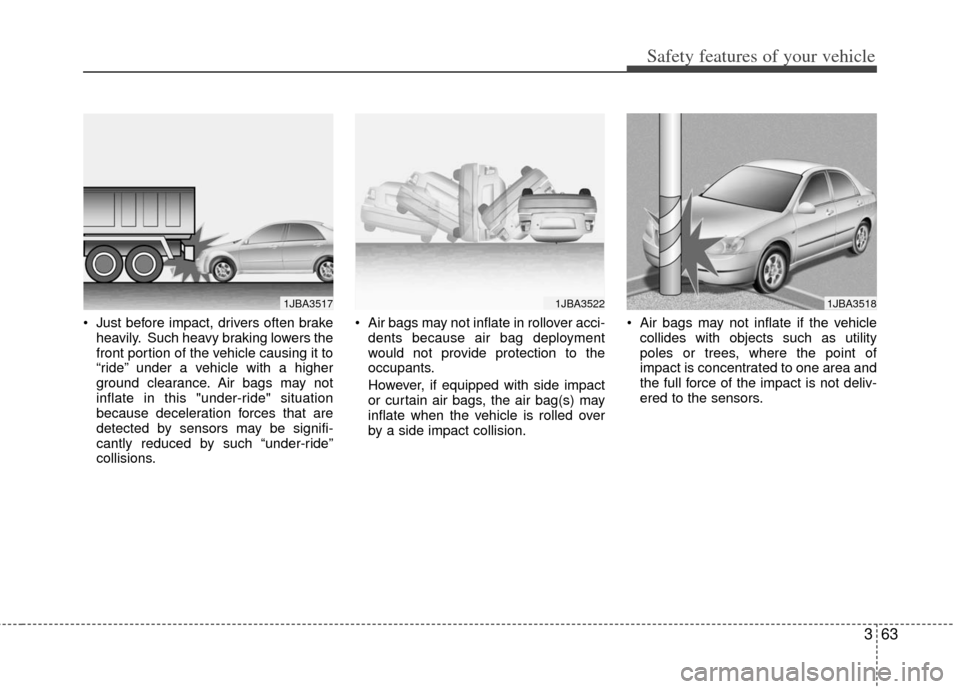
363
Safety features of your vehicle
Just before impact, drivers often brakeheavily. Such heavy braking lowers the
front portion of the vehicle causing it to
“ride” under a vehicle with a higher
ground clearance. Air bags may not
inflate in this "under-ride" situation
because deceleration forces that are
detected by sensors may be signifi-
cantly reduced by such “under-ride”
collisions. Air bags may not inflate in rollover acci-
dents because air bag deployment
would not provide protection to the
occupants.
However, if equipped with side impact
or curtain air bags, the air bag(s) may
inflate when the vehicle is rolled over
by a side impact collision. Air bags may not inflate if the vehicle
collides with objects such as utility
poles or trees, where the point of
impact is concentrated to one area and
the full force of the impact is not deliv-
ered to the sensors.
1JBA35171JBA35221JBA3518
Page 99 of 382

Features of your vehicle
12
4
✽
✽
NOTICE - Non-immobilizer
system
• Avoid trying to start the engine while
the alarm is activated. The vehicle
starting motor is disabled during the
theft-alarm stage.
If the system is not disarmed with the
transmitter, insert the key into the
ignition switch, turn the ignition
switch to the ON position and wait for
30 seconds. Then the system will be
disarmed.
• If you lose your keys, consult your authorized Kia dealer.
✽ ✽ NOTICE- Immobilizer system
• If the system is not disarmed with the
transmitter, insert the key into the
ignition switch and start the engine.
Then the system will be disarmed.
• If you lose your keys, consult your authorized Kia dealer.
✽ ✽ NOTICE
Always remove the ignition key, engage
the parking brake, close all windows
and lock all doors when leaving your
vehicle unattended.
CAUTION
Do not change, alter or adjust the
theft-alarm system because it couldcause the theft-alarm system tomalfunction and should only beserviced by an authorized Kia deal- er.
Malfunctions caused by improperalterations, adjustments or modifi-cations to the theft-alarm systemare not covered by your vehiclemanufacturer warranty.